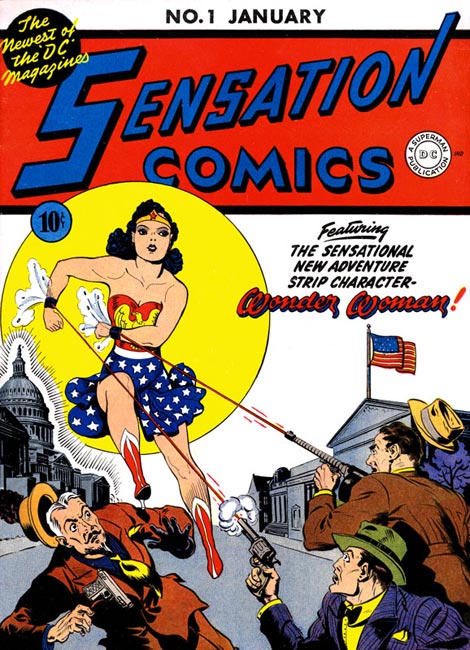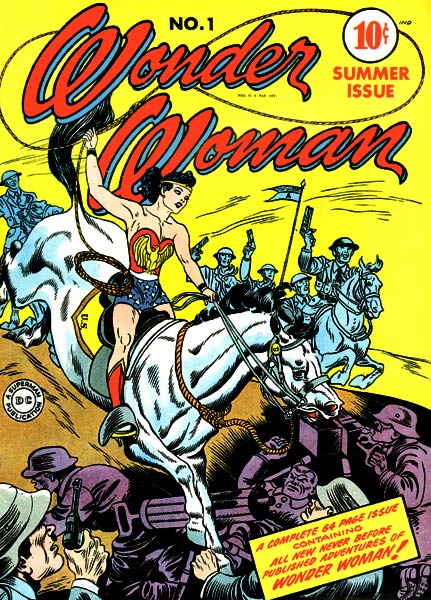The controversy surrounding Wonder Woman’s appearance goes all the way back to the beginning. The character’s visual design was a collaboration between Marston and artist H. G. Peter. Like Marston, Peter was much older than the other comic artists of his day. Both men were completely on board with women’s empowerment, in terms of both gender equality and sexual expression.
Peter found inspiration for Wonder Woman’s physicality in the work of Peruvian artist Alberto Vargas, famous for creating the Varga Girls, sexy pin-ups that appeared in Esquire magazine during World War II. You see, the outraged U.N. staffers were on-point calling Wonder Woman a pin-up girl, but her sex appeal is a feature, not a bug—and shaming her for sexiness is oppressive, not feminist.

An early annotated draft of her costume reveals that Wonder Woman’s midriff was originally bare. Apparently Marston decided that an ensemble consisting of nothing but a bra and culottes was simply too risqué, so Peter added a stripe of white (and later yellow) to indicate a belt. Marston knew that they were dancing at the edge of social acceptability, but as a promotional image by Peter plainly declared, Wonder Woman came to Man’s World to combat not only “man’s superiority” and “prejudice,” but also “prudery!”
Still, let’s be real. Wonder Woman’s look may have been a critique of puritanical prudishness, but it also sold books. Marston knew that sexual fantasy would sell books and often leaned into suggestive burlesque imagery. The problem remains not in sexuality, but in the cultural belief that it is somehow bad or impure.
Sensation Comics #1 tells the story of Wonder Woman’s first day in Man’s World. No sooner had Diana arrived in Washington, D. C. than she began to attract critical attention. The very first comment she overheard was from one elderly lady to another. “The hussy! She has no clothes on!” To which a younger man retorted, “Sour grapes sister! Don’t you wish you looked like that!”

This simple interaction was a subtle psychological trick, a call for introspection from readers who might criticize Wonder Woman’s outfit. If it is not hurting anyone, why did they care? No really, why?
Admittedly, the scene was depicted female objectification in a way that would never fly today, but none of these people or their opinions presented any real threat to Wonder Woman. Their petty prudishness or lascivious gazes meant nothing to her. How different would our world be today if we took a page from the Amazon training manual and refused to allow other people’s opinions to affect us?
Throughout the decades, Wonder Woman’s costume has evolved. Sometimes the changes have been subtle. For example, after her Winter 1941 debut in All-Star Comics #8 her culottes grew progressively tighter with each issue of Sensation Comics. By the time Wonder Woman #1 was released in Summer 1942, they had slowly morphed into shorts.
Other changes have been more drastic, such as in a 1990s story in which Diana lost the Wonder Woman title to another Amazon, and donned an edgy biker chick look, sporting a leather jacket and black bike shorts. Written by William Messner-Loebs, this story saw Wonder Woman’s sister Amazon Artemis wearing the famous bathing suit, but artist Mike Deodato, Jr.’s rendering of it was so salacious, it would have made even Marston squeamish.

Her breasts were barely supported by the low-rise bustier, suggesting a possible nipple slip at any moment. Her shorts became a tiny thong, which led some fans to refer to this chapter in Wonder Woman’s history as “the butt floss era.” If this were the only depiction the United Nations feminists had ever seen, their concerns might have been well-founded.
What Wonder Woman wears below the waist seems to cause a stir every few years, like that one time when a costume decision made national headlines, ignited outrage, and inspired mountains of satirical fan art. June 2010 marked Wonder Woman’s 600th issue, a significant milestone shared only with Superman and Batman, the only two superheroes whose comics have been continuously published longer than hers. This issue introduced an alternate universe Diana, who was smuggled away from Paradise Island as a baby and raised in Man’s World in a sort of underground Amazon cult. Her costume contained the familiar lasso and a re-imagined tiara, but introduced strange non-functional arm straps, a young adult emo persona, and—pants!

The reaction was fast and furious on all sides. Finally, she was showing some decency! Pants? Why would she cover those legs so I can’t ogle them? All the men get to wear pants! Why not Wonder Woman? Pants are symbolic of men’s oppression of women! Wonder Woman’s costume change made Fox News, NPR, and The Christian Science Monitor, among other news outlets.
Wonder Woman seems to repeatedly become a focal point for distrust of feminine power. She’s wearing too much. She’s wearing to little. Her hair is too short. Straight. Curly. She’s too thin. Too muscular. Her breast are too big. Not big enough. I think a lot of women might be able to relate to this kind of whiplash-inducing scrutiny.
Somewhere in reaction to all this bluster is the indomitable Wonder Woman archetype, swinging her bracelets to deflect these verbal slings and arrows, waiting for us to stop criticizing and focus on what actually matters. She is the empowered feminine goddess waiting for us to get over appearances and start focusing on taking care of ourselves and one another. Wonder Woman does not give a flying fuck what you think of her outfit. She does care that you’re wasting energy being a jerk.


